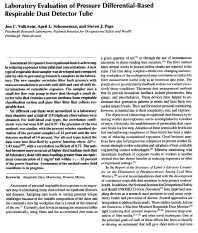Mining Publication: Laboratory Evaluation of Pressure Differential-based Respirable Dust Detector Tube
Original creation date: January 2000
Assessment of exposure to occupational dusts is a first step in reducing exposures to harmful dust concentrations. A new type of respirable dust sampler was developed and compared side-by-side to personal gravimetric samplers in the laboratory. The new sampler correlates filter back pressure with mass accumulation to provide mid-shift- and end-of-shift determinations of cumulative exposure. The sampler uses a small low flow rate pump to draw dust through a small detector tube that contains a porous urethane foam respirable classification section and glass fiber filter that collects respirable dust. Six different coal dusts were aerosolized in a laboratory dust chamber and a total of 119 triplicate observations were obtained. For individual coal types, the correlation coefficients were between 0.87 and 0.97. The precision of the two methods was similar, with the percent relative standard deviation of the personal samplers of 12 percent and the new detector method of 14 percent. For all coal types tested th data were best described by a power function where delta P = 1.43 mass (0.85), with a correlation coefficient of 0.73. The method becomes more accurate at higher dust loadings such that all laboratory data with mass loadings greater than an equivalent concentration of 2 mg/m3 fall within +/- 25 percent of the power function. Assessment of the method under field conditions is in progress.
Authors: JC Volkwein, AL Schoeneman, SJ Page
Peer Reviewed Journal Article - January 2000
NIOSHTIC2 Number: 20022682
Appl Occup Env Hyg 2000 Jan 15(1):158-164
See Also
- Determining the Spatial Variability of Personal Sampler Inlet Locations
- Dust Considerations When Using Belt Entry Air to Ventilate Work Areas
- Enhanced Utilization of Personal Dust Monitor Feedback
- Equivalency of a Personal Dust Monitor to the Current United States Coal Mine Respirable Dust Sampler
- Investigation of Coal Properties and Airborne Respirable Dust Generation
- Laboratory and Field Performance of a Continuously Measuring Personal Respirable Dust Monitor
- Laboratory Testing To Quantify Dust Entrainment During Shield Advance
- Miners' Views About Personal Dust Monitors
- New Tools To Monitor Personal Exposure To Respirable Coal Mine Dust
- Performance of a Light Scattering Dust Monitor at Various Air Velocities: Results of Sampling in the Active Versus the Passive Mode
- Content source: National Institute for Occupational Safety and Health, Mining Program


 ShareCompartir
ShareCompartir
